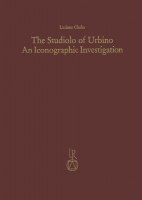Titelsuche
The Studiolo of Urbino – An Iconographic Investigation
1986
20,0 x 28,0 cm, 196 S., 109 s/w Abb., 8 farb. Abb., Leinen
ISBN: 9783882262766
20,0 x 28,0 cm, 196 S., 109 s/w Abb., 8 farb. Abb., Leinen
32,00 €
ISBN: 9783882262766
Kurze Beschreibung
The “studiolo” of Federico da Montefeltro in Urbino, the highlight of the Ducal Palace, is the most complete surviving example of an early Renaissance study. Its decorations (dated 1476) consist of a coffered ceiling, of inlaid panels depicting with impressice illusionism a fully-furnished “studiolo” interior, and of a painted frieze of 28 portraits of famous men. The latter have recently been re-assembled in the room (14 of them photographically, since their originals remain in the Louvre), for the first time since their dispersal in 1632. Much has been written on the decorations, but scholars have never attempted to analyse the various parts as an interacting whole, in order to establish whether they embody an iconographic programme. Such an investigation constitutes the main aim of the monograph. After an introduction on the cultural background, the various reconstructions of the painted frieze are critically surveyed to show why, in spite of continuing controversy,the arrangement proposed by Rotondi in 1973 (which the “Soprintendenza” of Urbino has followed) should be treated as definitive. The monograph also deals with the Gubbio “studiolo”, a derivative of the Urbino one (its woodwork is in the Metropolitan Museum). A thourough re-examination of the question of the reconstruction leads to the view that, contrary to common assumption, the “Liberal Arts” attributed to Justus of Ghent were not part of the original decorations. Both “studioli” are richly illustrated; specially taken colour photographs of the famous men in situ are also included in the volume.Ausführliche Beschreibung
The “studiolo” of Federico da Montefeltro in Urbino, the highlight of the Ducal Palace, is the most complete surviving example of an early Renaissance study. Its decorations (dated 1476) consist of a coffered ceiling, of inlaid panels depicting with impressice illusionism a fully-furnished “studiolo” interior, and of a painted frieze of 28 portraits of famous men. The latter have recently been re-assembled in the room (14 of them photographically, since their originals remain in the Louvre), for the first time since their dispersal in 1632.Much has been written on the decorations, but scholars have never attempted to analyse the various parts as an interacting whole, in order to establish whether they embody an iconographic programme. Such an investigation constitutes the main aim of the monograph.
After an introduction on the cultural background, the various reconstructions of the painted frieze are critically surveyed to show why, in spite of continuing controversy, the arrangement proposed by Rotondi in 1973 (which the “Soprintendenza” of Urbino has followed) should be treated as definitive.
The chapters on the intarsia and on the famous men make up the core of the monograph. A systematic comparison with allegorical cycles and other works connected with Urbino reveals that the intarsia designs incorporate, in symbolic form, series of concepts belonging to the celebratory repertoire. There are aslo veiled references to Federico’s wife Battista Sforza and to his heir Guidobaldo, as well as a range of ingenious games (visual and verbal puns, tricks of illusion...). The painted frieze is generally said to reflect randomly the personal preferences of Federico, yet, as a number of clues indicate, the choice of the heroes and their order have been in part calulated to translate humanist themes and ideals. The ensemble is finally treated as a visual panegyric, illustrating, with much “actuezza recondita” Federico’s moral, political and intellectual aspirations.
The monograph also deals with the Gubbio “studiolo”, a derivative of the Urbino one (its woodwork is in the Metropolitan Museum). A thourough re-examination of the question of the reconstruction leads to the view that, contrary to common assumption, the “Liberal Arts” attributed to Justus of Ghent were not part of the original decorations.
Both “studioli” are richly illustrated; specially taken colour photographs of the famous men in situ are also included in the volume.






 Neuerscheinungen 2023/2024
Neuerscheinungen 2023/2024
 Gesamtverzeichnis 2023/2024
Gesamtverzeichnis 2023/2024
 Katalog Oriental Studies & Linguistics
Katalog Oriental Studies & Linguistics
 Mittelalter
Mittelalter
 Deutsche Inschriften
Deutsche Inschriften
 Musiktherapie
Musiktherapie
 Literaturen im Kontext
Literaturen im Kontext